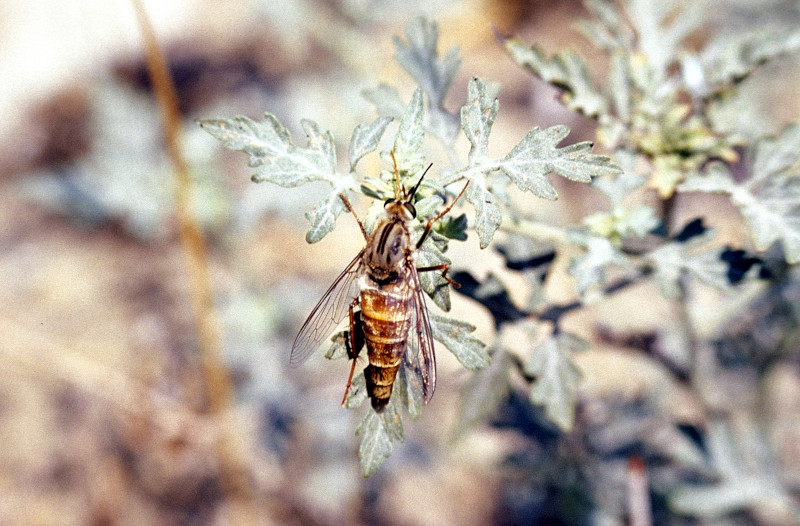
Delhi Sands flower-loving fly Facts
- This intriguing, and highly isolated species of insect, bears the cumbersome common name of the Delhi Sands flower-loving fly. The term might be lengthy, but it’s nevertheless also quite informative. For the moment, it has no other general name.
- Despite the length of the common name, though, it pales in comparison to the official, scientific name. That’s because it bears the burden of the formal name of Rhaphiomidas terminatus abdominalis! It’s also a subspecies of another variety of fly.
- It received that name at the hands of the respected American entomologist, Mont Aldebert Cazier. He achieved the first formal acknowledgement of it as a separate and distinct species. He recorded this scientifically noteworthy action in the year 1941.
- For now, the marvel of Nature does not appear on the IUCN Red List. It does, however, hold the status of Endangered in the country in which it lives. That status itself, though, remains an ongoing source of some controversy, due to solely political reasons.
- The Delhi Sands flower-loving fly nevertheless faces numerous threats to its continued existence. Given its habitat range, habitat loss obviously ranks high on that list. The greatest threat it faces, however, most likely consists of ongoing climate change.
Related Articles
Delhi Sands flower-loving fly Physical Description
The remarkable Delhi Sands flower-loving fly quickly draws the interest of those fortunate enough to encounter them. It does so for several reasons, though. Several of those factors pertain to its physical characteristics. For one, it ranks as a fairly large variety of fly.
In this area, as well as overall appearance, the species displays no noticeable degree of the physiological trait of sexual dimorphism. In terms of size, both genders vary significantly in length. Overall, however, mature adults attain an average size of about 1 in (2.5 cm).
The body further develops as elongated, and tapers at both the head and tail. Its proboscis also develops as highly elongated, as well as being tubular-shaped. It also develops relatively long wings for a fly. These also typically display a somewhat elongated shape when open.
The impressive Delhi Sands flower-loving fly also presents a striking visual image, as well. Its body displays broad brownish band across the abdomen. Separating these it further shows narrow bands of an orange-yellow hue. Small brown spots also sometimes manifest.
Yet, the rest of its body presents strikingly different shades. This creates a strong contrast. The head develops shades of green and ocher. But the legs really set this off. That’s because these appendages typically present a bright orange color, with darker spots at the joints.
- Kingdom: Animalia
- Phylum: Arthropoda
- Class: Insecta
- Order: Diptera
- Family: Mydidae
- Genus: R. terminatus
- Species: R. t. abdominalis
Delhi Sands flower-loving fly Distribution, Habitat, and Ecology
The amazing Delhi Sands flower-loving fly evolved as endemic to a general region of the world already well known for its variety of wildlife. That’s due to the fact that it developed as native to a portion of North America. Within that area, though, it’s range is limited.
In point of fact, it’s extremely so. This product of evolution inhabits an extremely tiny area of the United States. More precisely, it appears in only a tiny part of southern California. Evidence additionally indicates that its range never exceeded 40 sq mi (100 sq km)!
Sadly, however, roughly 98% of that original territory now remains undeveloped for human habitation. Fortunately, a private conservation group purchased 7 separate small parcels of land, to set aside as a sanctuary. This, though, only totals about 100 acres (40.4 ha).
Its original and remaining habitat remains the same. That’s comprised solely of the Delhi Sand Dunes formation. This ancient area of arid, inland dunes also serves as the only known home to several other recently discovered, but as yet unnamed insect species.
Detailed information on the life cycle of the Delhi Sands flower-loving fly presently remains limited. As part of its name indicates, mature adults appear to feed exclusively on nectar. It also appears to feed exclusively on nectar from the blooms of the California buckwheat.
Its total lifespand also remains undetermined. It’s believed, though, that its larval stage last 1-2 years. That period of its life appears to be spent entirely underground. Adults begin to emerge during early summer. Once these appear, however, each only lives a few weeks.
Species Sharing Its Range
Check out our other articles on 4 Fabulous Flora of Florida, Peacock Butterfly, Atchafalaya Basin, Northern Flying Squirrel, American Wintergreen, European Eel, Hyacinth Macaw, Hermann’s Tortoise
